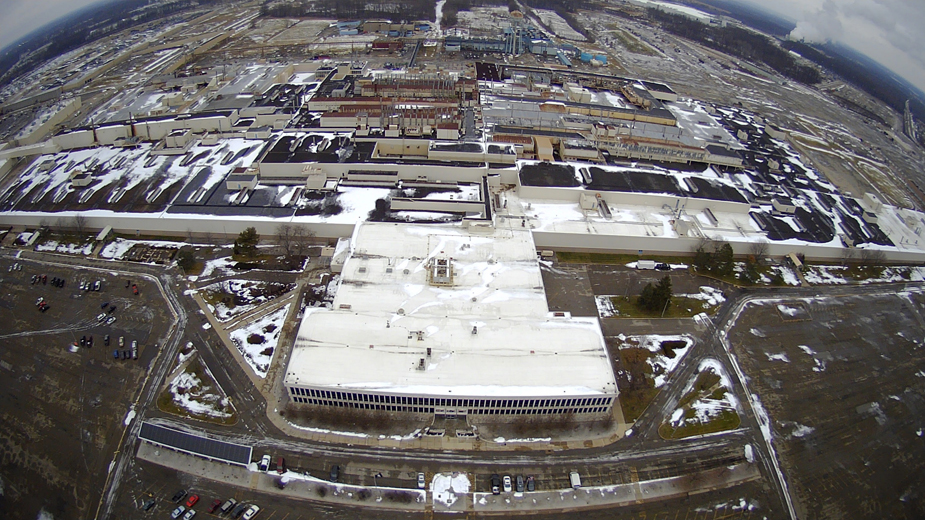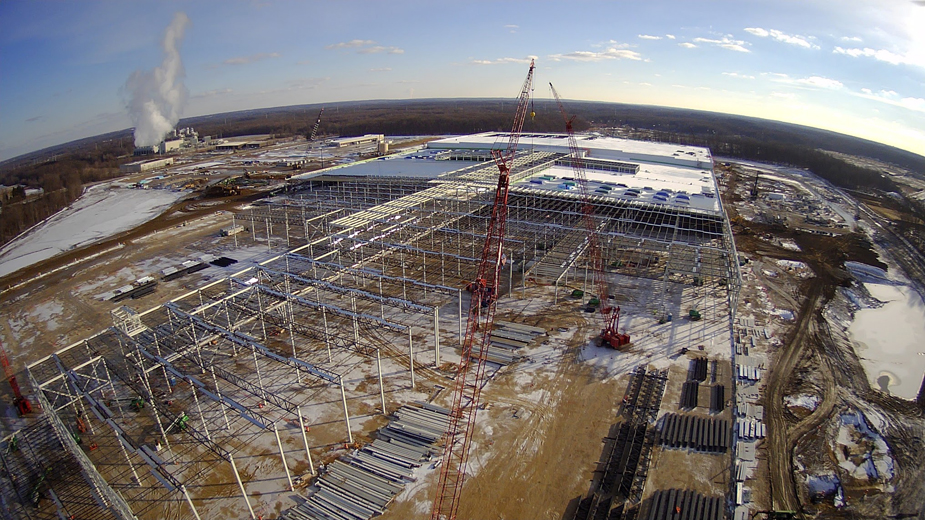LORDSTOWN, Ohio – Recent property transactions by Ultium Cells LLC – the joint venture between General Motors and LG Chem that is building a $2.3 billion electric-vehicle battery manufacturing plant in Lordstown – is raising speculation about whether the company has additional development plans for the site.
According to documents filed with the Trumbull County auditor’s office in mid-November, Ultium acquired 144 acres just south and west of where it is constructing its 3 million-square-foot plant along state Route 45 in the village. The acquisition nearly doubles the size of Ultium’s land holdings there to more than 300 acres.
Documents show that Ultium acquired a 45.6-acre parcel at the corner of Route 45 and Hallock-Young Road and another contiguous 98.6-acre parcel that extends west across a parking lot and then north along an old railroad spur for about 1,600 feet.
This is in addition to the 158 acres along Route 45 that GM purchased in March from NorthPoint Development for $5.1 million, where construction continues on the plant.
The additional land was acquired from Lordstown Motors Corp., according to the auditor’s office. In November 2019, GM sold its Lordstown Assembly plant and adjoining land to Lordstown Motors, which is retooling the factory to accommodate production of a new electric pickup, the Endurance. The latest transaction merely returns the land to GM via Ultium.
The transactions were recorded on the auditor’s site Nov. 13 and did not list a purchase price.
GM spokesman Dan Flores says Ultium needs the additional land “primarily to support the placement and routing of utilities to service the battery plant.” He did not provide any additional details related to the transaction.
The acquisition, however, has led to chatter as to whether Ultium might expand at the location or provide space for potential suppliers to the plant. Two sources who asked not to be identified say there are rumors circulating but they’ve heard nothing official from either the company or the general contractor on the project. One of those sources says while it’s plausible that Ultium would use the land to run utilities, the amount of new acreage is so significant that it could more than accommodate additional development.
Martin Loney, president of the Western Reserve Building and Construction Trades, says that he’s had no confirmation about expansion plans at the site once the current plant is finished.
“I don’t have anything that’s indicating that,” he says. “We’re hearing the same rumors, but nothing to talk about.”
Meanwhile, work progresses at a rapid clip on the project, Loney says, noting about 350 tradesmen are on site and he anticipates between 800 and 1,000 in total could be employed during the construction phase.
Should Ultium decide to expand its presence in Lordstown, Loney says that the local trades are more than ready to work with the company to build a new project.
“This just seems like a great future for the Valley,” he says of the battery plant. “I would love to see it. It could turn the Valley around as a large hub in the country for battery production.”

GM’s Flores says that the project remains on schedule to open during the first quarter of 2022.
“2021 is going to be a big year for Ultium,” he says. “We’ll bring on the workforce, hourly and salary, and fill out the entire team.” Ultium has said the battery plant will employ more than 1,100 by the end of 2022. The plan is to have about 400 hired by the end of calendar year 2021 and continue the company’s planned equipment installment throughout the following year.
“These plans are rather fluid as we learn how long it will take to train the workforce for these new high-tech jobs in battery cell manufacturing,” Flores says.
While last year presented its share of challenges, Flores notes that the COVID-19 pandemic did not impede the project’s momentum. One major reason was that early on in the health crisis Gov. Mike DeWine determined that construction was an essential business, which allowed work to continue through the spring and summer.
Moreover, GM has dedicated itself to an all-electric future for its vehicle portfolio. And Lordstown will play a major part in this future, Flores says.
To date, the automaker has identified three assembly plants – Hamtramck in Detroit, Spring Hill in Tennessee, and Orion in Michigan – to manufacture electric vehicles.
Among the new all-electric models slated for production in late 2021 and 2022 are the GMC Hummer EV pickup and the Cadillac Lyriq, while other EV models such as two Buick SUVs are in the pipeline. GM has said it will allocate more than $20 billion toward electric vehicle programs between now and 2025.
These vehicles will source their battery cells from Ultium. “For each one of those vehicles, we’re going to need battery cells to power them,” Flores says.
Earlier this year, GM announced it would invest $2 billion in the electric vehicle startup Nikola and also supply Ultium batteries to its planned Badger pickup. However, GM has since backed off its investment to build the Badger. But the Ultium battery supply deal remains intact should the pickup be produced.
The automaker is also a 4% stakeholder in Lordstown Motors. GM invested $75 million – $50 million of which was in-kind investments through a line of credit it extended to Lordstown Motors so that company could buy and begin to retool the former GM plant for production of The Endurance, set for September.
Flores says GM’s core business remains very important and the conversion to an all-electric platform will take some time.
“We’re in a really good position to not only strengthen our current business, but also fund that future,” he says. “What we’re building in Lordstown is going to be critical for the future viability of the company.”
GM has a long history in the Mahoning Valley, Flores notes, and the new battery plant extends this commitment. “We manufactured products in the Mahoning Valley for more than 50 years,” he says. “We have a strong working relationship with the village of Lordstown and the state of Ohio.”
GM shuttered its Lordstown Assembly plant in March 2019, citing sagging sales of its passenger vehicle, the Chevrolet Cruze. Flores acknowledges the decision to close the plant caused hardship for those employees who either lost their jobs or had to transfer to other plants.
Last year, the Ohio Tax Credit Authority determined that GM had to repay the state $28 million in tax credits and the Mahoning Valley another $12 million for violating two tax incentive agreements it signed with the state in 2009.
Flores says the automaker is still working with the state on the final details of how the money will be returned, emphasizing the company’s decision to close Lordstown had nothing to do with the workforce or the region.
“It’s a very difficult decision we had to come to because people stopped buying small cars. And we couldn’t justify continuing production of the Cruze,” he says. “The workforce did everything it was asked to do. We had a good relationship with the local union.”
Indeed, the decision to build the new battery plant in Lordstown is a nod to the region’s commitment to excellence in manufacturing, Flores says: “It’s important for the community and it’s important for the company.
“In the end, where one opportunity ended another door opened. And that door is Ultium Cells. We’re really excited about it.”
Pictured: The Ultium Cells battery plant is rapidly taking shape. Above is a drone shot taken Dec. 29.
